Humbled by the response I received after my first article, I couldn't wait to get back to the keyboard and write. Your feedback was awesome, and thanks for making me feel right at home! As promised, I'm going to continue the series on Loeffler's time spent at Auburn. Originally I was going to focus on why he didn't have much success as the Tiger's offensive coordinator, but once it became obvious that most of the article would be about Kiehl Frazier's shortcomings, I decided to change my approach. College athletes are amateurs, usually barely adults, so I'm going to avoid criticizing them too harshly.
Instead of writing an entire article documenting every poor throw of Frazier's year at Auburn, I'm going to focus on the specifics of Loeffler's favorite short passing packages. Let's not focus on the results at Auburn for this article (we already know they were bad), let's focus on whether or not the packaged routes were getting receivers open. If we see evidence that Loeffler can get his playmakers into space we should feel good about his chances for success at Tech.
Short passing game... Who cares?
Why does it matter if Loeffler has a good short game? Why bother throwing it short to begin with? Is it necessary to have a successful short passing game in order to be a good offensive coordinator? Can't you just run the ball rather than throw a five yard pass?
Over the past two decades, offensive coordinators have put more emphasis on horizontally stretching defenses with the pass. This change is arguably the most important and recognizable change in the way the game is played. By stretching the defense along the entire line of scrimmage, the short passing game opens up rushing lanes as well as vertical passing routes. We see here what happens if the offense doesn't attack LBs who play with poor pass leverage.
2:45–2:53
The LB who would normally be covering the slot receiver cheats too far to the inside. We know that Auburn had a potent rushing attack, but due to this alignment Auburn has no hope of blocking him. The angle for the WR is too severe and we see the LB run right past him. Although the LB doesn't make the tackle he does blow up the play and slows down the RB, allowing a teammate to make the stop.
In order to combat this aggressive alignment, Auburn MUST target the uncovered slot receiver. The safety is in a good position to stop a deep play action pass but is too far off to stop a short throw. With the LB too far inside to stop an outside route there is a large gap in the secondary. By failing to audible to a short pass, Auburn's rush play is doomed.
Picking up what the Defense is Putting Down
With the attention that Loeffler's rushing attack draws and the large cushion his play-action game affords his WR's, he needs to be able to consistently attack the soft spots in a defense to get easy yards. So how does he do attempt to do that?
One way is with every Hokie's favorite pass play, the WR screen.
15:25–15:38
Now there has been a lot of gnashing of teeth over the use of the WR screen at Tech. I've heard the bellyaching at games, and read a lot of posts online from a vocal portion of the fan base who detest every time they see a WR screen. Sadly for them, the WR screen is here to stay. Forever. As long as defenses don't match up numbers on the perimeter we will see this play.
The play is as simple as it gets. If the offense has an equal number of blockers as the defense does tacklers, the screen should work everytime (of course it doesn't work EVERY time, WR's aren't known for their blocking skills).
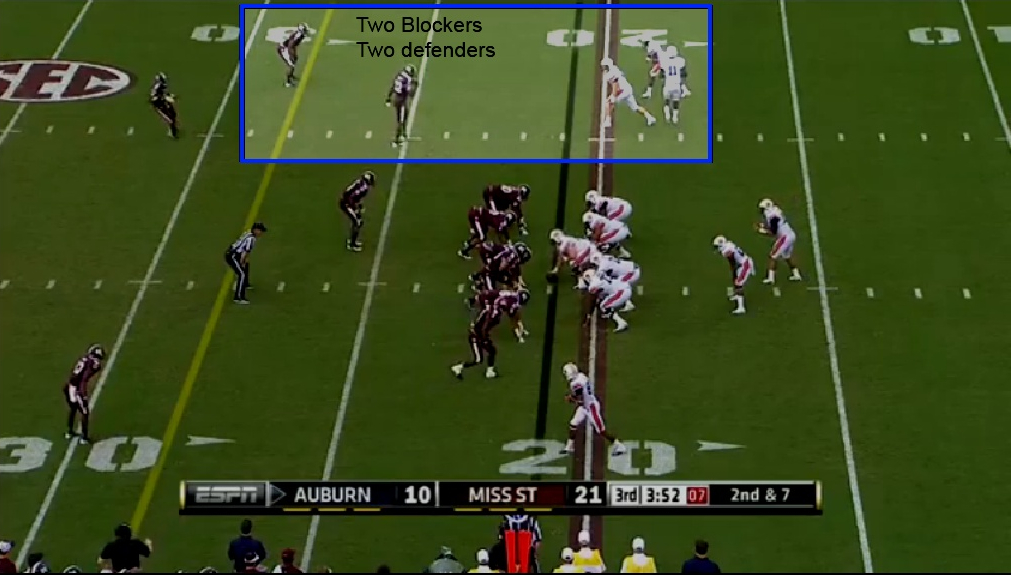
With two defenders and two blockers, the Tigers get the ball to their playmaker in space and he picks up some very good yardage. Simple but effective. Every high school coach in the country has this in their playbook though. What were Loeffler's "bread and butter" plays? Which concepts did he believe in enough to run when he REALLY needed a first down?
During Stinespring's tenure as head offensive honcho, I frequently lamented the lack of imagination in the short pass game. Sure Tech would send it's WR's on short pass routes but the route packages never seemed to have a rhyme or reason. You can't just say "Danny Coale, go run a curl" and expect to have consistent success, you need to have well defined and self-contained concepts. Concepts which will work every time regardless if the secondary is lined up in man, cover-3, or blitzing. Too often it seemed that when Tech needed a short yardage pass, all the WR routes would be covered and the WR's would stand around looking lost.
Trying to scout out some of Loeffler's packages at Auburn was frustrating at first, mostly because Auburn simply didn't throw short very often with Frazier at QB. After finally finding a handful of the type of plays I was looking for, I started to get excited. Very excited.
Those defenses better check their hypotenuses
Norm Chow is one of my favorite offensive minds in football. His work on the short passing game at BYU laid the groundwork for much of the spread phenomenon we've seen the past decade. Without a way to control the ball by throwing it short, teams wouldn't be able to operate almost exclusively out of shotgun like so many do today.
In one of his AFCA presentations about his time at BYU, Norm chow states that when putting together his passing game plan he wanted "to create triangles. Everybody understands horizontal stretch routes and vertical stretch routes. At BYU, we like to develop oblique stretches" (Emphasis is mine). So what is an oblique stretch? An oblique stretch is merely a way to attack the different levels of a pass defense. On paper the oblique stretch will get you a player open against any coverage, be it man, cover-2 or cover-3. The first few games of Auburn's season shows that Loeffler is quite the fan of this package.
Against a run-heavy team like Auburn, most defenses prefer to run some form of a cover-3, where a safety stays in underneath coverage with the LB's and both CB's and one safety drops into deep coverage.

This allows the safety to help match-up against the run while also allowing the defense to protect against deep passes. The cover-3 is susceptible to short passes though, and Loeffler uses his WR's to create triangles to exploit the holes in the cover 3. Below, we see how difficult it is to defend this combination.
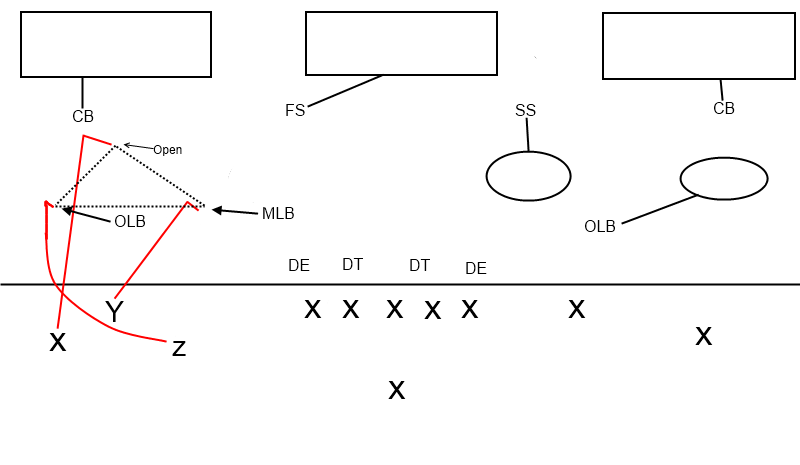
The defense has little hope of covering all three receivers in this coverage. The "Y" receiver will run a "snag" route towards the middle of the field. Meanwhile the "Z" receiver will run a route towards the sideline, and the "X" receiver runs at the CB. The CB will drop deep, as he has deep third responsibilities and must respect the threat of a vertical route. If the MLB jumped the snag route and the OLB widened out to defend the "Z" receiver, then the QB has a nice passing lane to hit "X" on the curl. The only way to stop X's curl is to rotate the OLB or MLB in front of his break, which would leave the snag or the sideline route open.
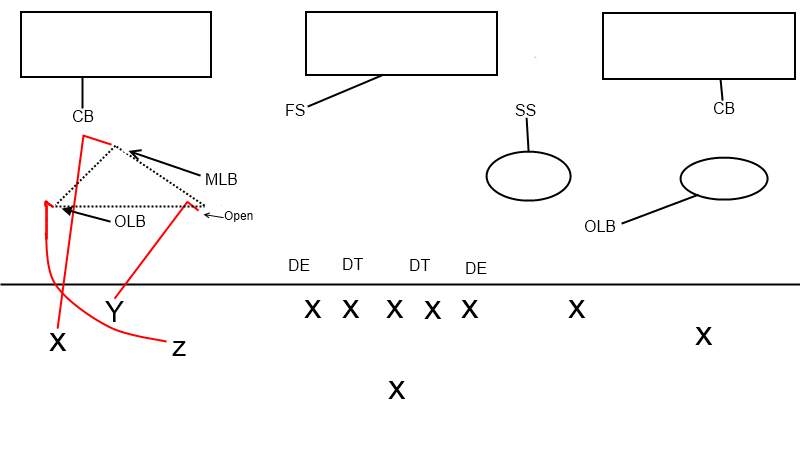
The triangle concept isn't limited to the sideline, it can be run towards the middle of the field as well. Loeffler does a good job at mixing the triangle concept into different looks and formations. While Frazier struggles to make the correct read and throw, Auburn does manage to get WR's open against their opponents.
16:06–16:30

On this play Auburn throws a triangle at the middle of Mississippi State's defense. Auburn's underneath WR run their routes too close together, but the LBs and strong safety still get sucked into them. This opens up a hole in front of the deep safety. Running into that void is the top of the triangle, the player Frazier has to get the ball too. Frazier sees the blitz, panics, and throws it to the wrong receiver. Despite the poor outcome, Hokies should take this play as a positive since it shows the strong principles Loeffler's short passing game is based on.
8:53–9:02
Here's another play that looks discouraging until you see what Loeffler was trying to accomplish. This was in Auburn's first home game of the season, vs ULM. ULM drops into what appears to be a "quarters" defense, one where both safeties and both corners drop deep and the three linebackers take the underneath routes. Loeffler manages to get a man open for at least first down yardage, but the pass is knocked down at the line of scrimmage. The interesting thing is how Loeffler manages to set up the triangles concept without putting three WR's on the same side of the field.
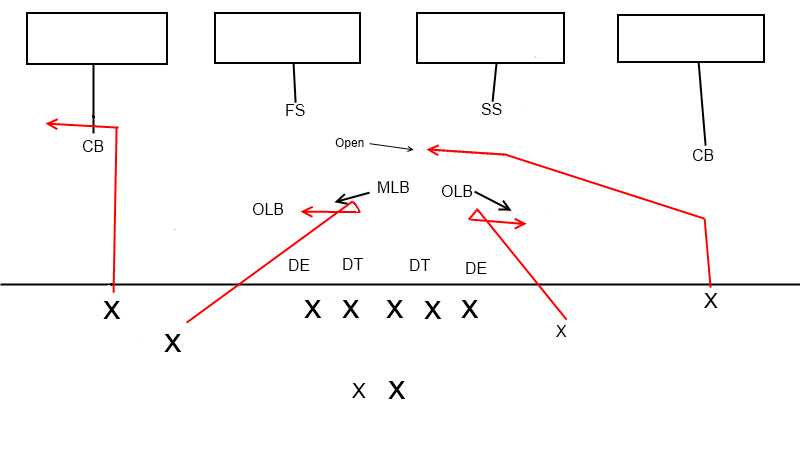
Auburn starts off with two WR's on both sides of the formation. On the left, Loeffler has the outside receiver run an out route and he brings the inside receiver across the middle of the field. This occupies the MLB while the inside receiver from the right side of the formation occupies his OLB. A nice touch was having the underneath receivers pivot towards the sideline after running a hitch, opening up the window in between the LB's a couple extra steps for the QB.
The outside receiver on the right then runs a slant/dig to the middle of the field in front of the Safeties. With both safeties dropping deep and the LB's covering the hitches, the top of the triangle is wide open for Frazier. Typical of his time at Auburn, Loeffler's nice play design is wasted because of an unlucky tipped pass at the LOS. Having a tall QB like Logan will make these short throws over the middle much easier.
Triangles at Tech
What happens when a defensive coordinator figures out what Loeffler is trying to do and decides that enough is enough? Let's find out what Bud Foster (the best defensive coordinator in the country) does.
0:46– 0:53
By now hopefully you recognize the triangle combination that Loeffler is using here. His two inside receivers run short hitches and the outside receiver at the bottom of the screen runs a slant. When the LB is too slow to react to the hitch, Logan takes the safe throw for a nine yard gain. Foster has seen Loeffler's short passing game in the scrimmages leading up to the spring game and I imagine he isn't going to be content giving up 9 yards that easily all day long. His response? Overload the side threatening the "triangle" concept, while relying on man coverage on the backside.
1:02–1:14
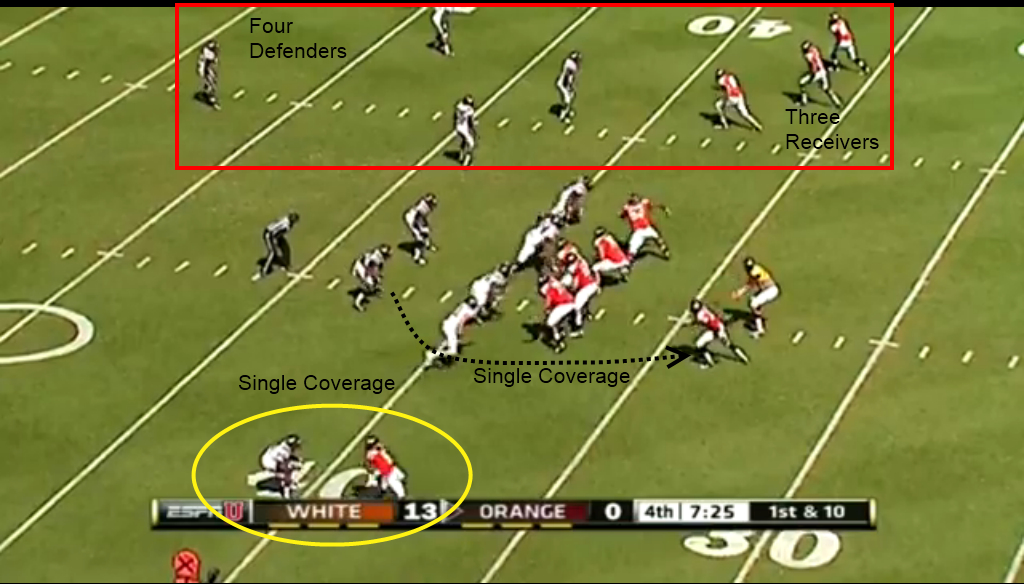
At the top of the screen, we see Foster placing four defenders with the bunched WR's. Foster will be able to stop any Triangle combination they run here, as he has two defenders to jump the underneath routes and two remaining to double a deep route. Foster also has to keep two linebackers in the box to protect against a QB-run play. This leaves one-on-one man coverage at the bottom of the screen. Josh Stanford beats his man with a slant move, the LB is slow rotating over because he has coverage responsibilities on the RB, and Stanford is off to the races. Logan Thomas does a great job of recognizing the single coverage pre-snap, he does a great job handling a bad snap, and he does a great job getting the ball to his man in time. The only way to stop the Triangle short passing game, other than just having better athletes, is to over commit defenders. This will leave holes elsewhere in your defense that should be exploited. It'll be up to Loeffler to teach Logan where those holes appear.
The more I study what Scot Loeffler tried to accomplish in his one year at Auburn, the more excited I get about his future at Tech. His Norm Chow influenced passing game had players running open against aggressive defenses. Frank Beamer wants a ball-control offense which can pick up first downs and keep his defense rested. Loeffler has all the necessary knowledge to accomplish just that. The only questions that remain are about his ability to actually coach, not just draw up plays.

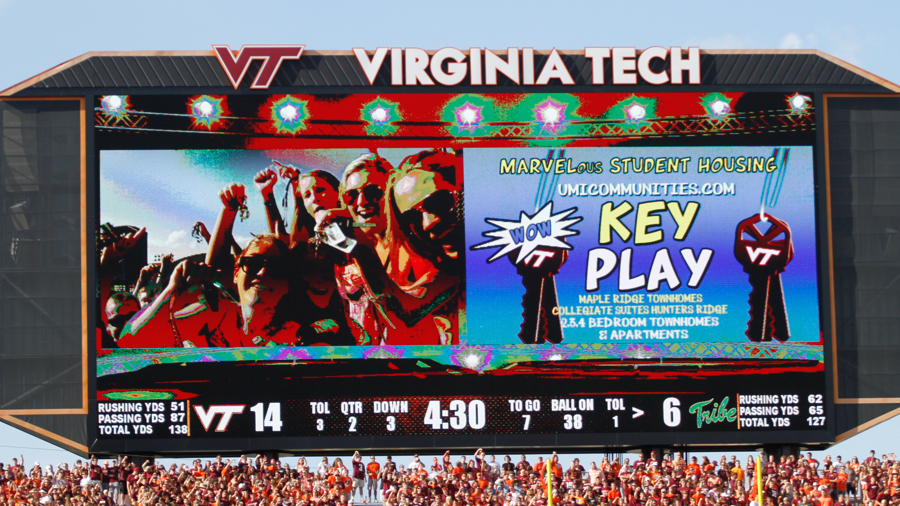
Comments
Please join The Key Players Club to read or post comments.
Please join The Key Players Club to read or post comments.
Please join The Key Players Club to read or post comments.
Please join The Key Players Club to read or post comments.
Please join The Key Players Club to read or post comments.
Please join The Key Players Club to read or post comments.
Please join The Key Players Club to read or post comments.
Please join The Key Players Club to read or post comments.
Please join The Key Players Club to read or post comments.
Please join The Key Players Club to read or post comments.
Please join The Key Players Club to read or post comments.
Please join The Key Players Club to read or post comments.
Please join The Key Players Club to read or post comments.
Please join The Key Players Club to read or post comments.
Please join The Key Players Club to read or post comments.
Please join The Key Players Club to read or post comments.
Please join The Key Players Club to read or post comments.
Please join The Key Players Club to read or post comments.
Please join The Key Players Club to read or post comments.
Please join The Key Players Club to read or post comments.
Please join The Key Players Club to read or post comments.
Please join The Key Players Club to read or post comments.
Please join The Key Players Club to read or post comments.
Please join The Key Players Club to read or post comments.
Please join The Key Players Club to read or post comments.
Please join The Key Players Club to read or post comments.
Please join The Key Players Club to read or post comments.
Please join The Key Players Club to read or post comments.
Please join The Key Players Club to read or post comments.
Please join The Key Players Club to read or post comments.
Please join The Key Players Club to read or post comments.
Please join The Key Players Club to read or post comments.
Please join The Key Players Club to read or post comments.
Please join The Key Players Club to read or post comments.
Please join The Key Players Club to read or post comments.
Please join The Key Players Club to read or post comments.
Please join The Key Players Club to read or post comments.
Please join The Key Players Club to read or post comments.
Please join The Key Players Club to read or post comments.
Please join The Key Players Club to read or post comments.
Please join The Key Players Club to read or post comments.
Please join The Key Players Club to read or post comments.
Please join The Key Players Club to read or post comments.
Please join The Key Players Club to read or post comments.
Please join The Key Players Club to read or post comments.
Please join The Key Players Club to read or post comments.
Please join The Key Players Club to read or post comments.
Please join The Key Players Club to read or post comments.
Please join The Key Players Club to read or post comments.
Please join The Key Players Club to read or post comments.